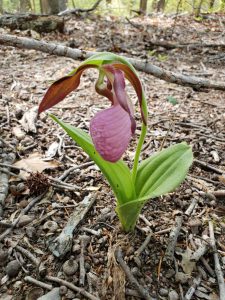Mollie McNeel
Medill Reports
If a gardener tells you that their plants had died and now have come back to life years later, you might think they’ve gone crazy. But actually, they may be on to something.
Some fully-grown plants can “hibernate” in the soil for up to 20 years, researchers from the Smithsonian Environmental Research Center (SERC) discovered and reported their findings in a study published in the May issue of Ecology Letters.
The so-called “Rip Van Winkle” plants, nicknamed after the fictional character who slept for two decades, include many species of orchids and some ferns.

An international team of researchers, including two Smithsonian scientists, have been working to understand the patterns and causes of dormancy in a variety of adult plant species. Dormancy only occurs in some plants in a population in any given year, and depends on individual plant circumstances. If a plant produces a new shoot that then gets destroyed, the plant will more than likely remain dormant through upcoming growing seasons to allow time to stock up on its necessary nutrients. While dormancy in seeds has been widely acknowledged and studied for decades, dormancy within fully-grown plants is far more mysterious.
“There is this hidden stage we didn’t know about, and it’s much more widespread than people had previously appreciated,” said Melissa McCormick, contributing author on the study and SERC molecular ecologist.

To date, this research is the most comprehensive and widespread study conducted on dormancy in adult plant species. Scientists studied 114 plant species in 24 different families, using data from a vast array of datasets and published studies on plant dormancy.
The team realized that whether or not a plant will go dormant often depends on what it will “cost” the plant to produce a sprout—and found that plants with shorter lifespans (around five to seven years) are more likely to go dormant.
This may be because plants with longer lifespans are able to stock up on nutrients and store them underground, which can then be used as a backup source to produce another shoot in case the first one dies. Plants with shorter lifespans may not have this ability, giving them fewer opportunities to produce a shoot and making it much more “costly” if it dies, McCormick explained. Therefore, plants with shorter lifespans and shorter root systems may be more cautious prior to initiating aboveground growth.
In McCormick’s words, plants have to decide, “If I produce a shoot and it gets eaten, do I have anything left to use to produce a shoot again in another year?”
Plants that go dormant have been found to remain underground for anywhere from one to over 20 years. Since the dormant plants aren’t adding any resources by photosynthesis, they’re likely obtaining resources from fungi—another key to being able to go dormant and emerge in the future.
Almost all plants on land form beneficial relationships with certain kinds of fungi. But fungi play a special role in helping orchids and other dormant plants survive underground. These fungi provide essential nutrients such as carbon, nitrogen and phosphorus while the plant is nestled under the soil and unable to photosynthesize.

“The fungal side [of this research] has changed over time,” explained Dennis Whigham, SERC plant ecologist and co-author. “It initially started out as asking which types of fungi are present and if we can grow them in the lab.” However, as genetic research evolved, researchers were able to use DNA to search for fungi in the soil. This allowed them to be able to take a soil sample, look at that sample and see if the fungus was present near specific orchid species. “Now, we not only can determine if the fungus is present, but we can see how much of it in the area as well,” said Whigham.
Prior to the international study, the research team thought dormancy would be more prevalent at colder latitudes and higher elevations, where the growing season is shorter. But to their surprise, they discovered dormancy was more common near the equator, where threats like disease, competition and predators are more severe.
“Plants up in high latitudes grow really slowly and are really long lived. These plants store a lot more materials such as nutrients below ground,” said McCormick. “In the tropics, factors such as climate are often more benign and predictable, but predators, competition and plant diseases are not.”
Discoveries like this could be critical for conservation in the coming years. When looking at plant populations—especially those of endangered orchids—it’s important to know that there could be more than meets the eye.
“We can’t just go out one year, see what’s going on and move on,” said McCormick. “It’s not going to give us the answers we need in terms of the species or understanding how these plants are reacting to environmental changes.”
This story was originally posted on the SERC website.
PHOTO AT TOP: Pink lady’s slipper (Cypripedium acaule), an orchid that can remain dormant for over 20 years. (Credit: SERC)


